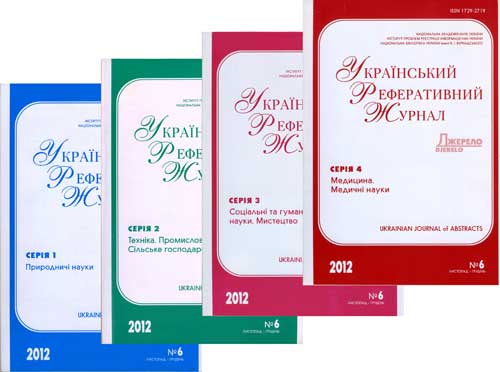РЕФЕРАТИВНА БАЗА ДАНИХ "УКРАЇНІКА НАУКОВА"
Abstract database «Ukrainica Scientific»
Бази даних
Реферативна база даних - результати пошуку
|
|
Пошуковий запит: (<.>ID=REF-0000743162<.>) | |||
|
Загальна кількість знайдених документів : 1 |
|||
Вадзюк С. Н. Психофізіологічні особливості осіб юнацького віку з підвищеною вестибулярною чутливістю / С. Н. Вадзюк, Р. М. Шмата // Експерим. та клініч. фізіологія і біохімія. - 2019. - № 3. - С. 61-67. - Бібліогр.: 16 назв. - укp. Aim - to assess the relationship among neuroticism, well-being, activity, mood, anxiety and vestibular resistance. The survey was attended by 612 students aged 17 - 19 years. We used the questionnaire method to select individuals with high sensitivity of the vestibular analyzer. Neuroticism was determined using the questionnaire of Eisenck. The feeling, activity and mood were evaluated by the questionnaire before and after the vestibular loading. The level of personal and situational anxiety was determined by Spielberger's method. Personal anxiety was evaluated before, and situational after vestibular loading. The vestibular load was carried out by rotational test, using a Barani's chair. According to the results of the questionnaire, we found 114 adolescents with an increased sensitivity of the vestibular analyzer, who was 18,6 %. Adolescents with reduced vestibular resistance, high neuroticism was in 43,9 % of cases, the average was 36,9 %, and the low - 19,3 %. We did not observe persons with very high neuroticism. The mean of neuroticism in the control group was 11 points, and in the hypersensitivity group of the vestibular analyzer - 14,7 points. The arithmetic mean scores of well-being, activity and mood before and after the rotation test differed in the groups with proper and reduced vestibular stability. We found a deterioration in well-being in people with reduced vestibular stability. Activity to load did not differ. We observed its change in the study groups after the rotation test, namely the decrease in the group with increased vestibular sensitivity, compared with the control group. Mood levels differed between the groups with proper and reduced vestibular stability, both at rest and after rotation. The level of personal and situational anxiety in the group with decreased vestibular stability was higher than in the group with high functional activity of the vestibular analyzer. Comparing situational anxiety depending on vestibular stability and neuroticism, we observed higher scores in students with reduced vestibular stability and low, medium, and high levels of neuroticism than in the group with proper vestibular stability and corresponding neuroticism. Our research shows that neuroticism, anxiety and vestibular stability are interrelated. Since, in the vast majority of persons with vestibular dysfunction, certain peculiarities of the mental state are formed, therefore, the level of neuroticism and anxiety of the subjects should be taken into account when planning diagnostic and treatment. Conclusions: persons with reduced vestibular stability are associaded with increased neuroticism. The feeling and mood are lower in adolescents with increased vestibular sensitivity. Vestibular loads significantly reduce the feeling of state of health, activity and mood in adolescents with reduced vestibular stability. Students with reduced vestibular resistance have high personal and situational anxiety. Індекс рубрикатора НБУВ: Р733.683.71 + Ю937.42 + Ю948.43-953.6-734 Рубрики: Шифр НБУВ: Ж16160 Пошук видання у каталогах НБУВ Додаткова інформація про автора(ів) публікації: (cписок формується автоматично, до списку можуть бути включені персоналії з подібними іменами або однофамільці)
| |||
| Національна бібліотека України імені В. І. Вернадського |
 |
| Відділ наукового формування національних реферативних ресурсів |
 |
| Інститут проблем реєстрації інформації НАН України |
Всі права захищені © Національна бібліотека України імені В. І. Вернадського